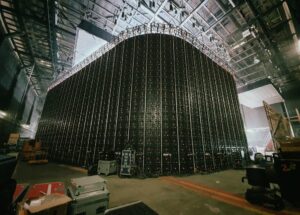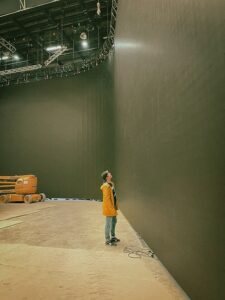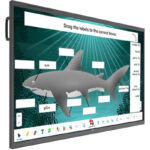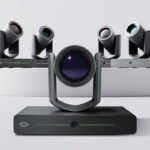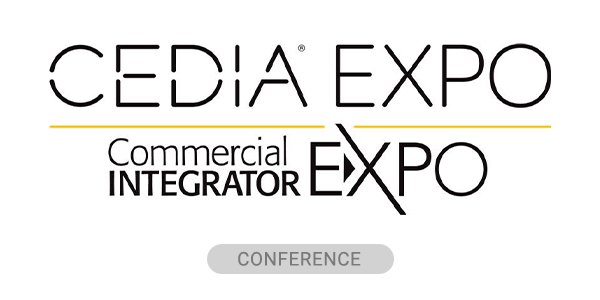Global LED manufacturer INFiLED showcased its array of indoor and outdoor LED screens at this year’s NAB Show. The company also hosted a “Poor Things” panel, featuring notable partners from HALOSTAGE and ICT AG to discuss the production details behind the acclaimed film.
Awe-Inspiring Displays
One of the highlights of the booth was INFiLED’s LED displays, designed for virtual production, broadcasting and exhibitions. The setup included a curved backdrop that combined INFiLED’s DB1.9 and X1.9 series, utilizing CBSF technology, with an AR5.9 series ceiling screen that employed Brompton Technology’s TrueLight and Tessera G1 receiver card. The visually stunning content displayed on the curved screen was created by Render Foundry.
The CBSF technology ensures color shift-free performance, brightness uniformity and consistent color temperature across a wide viewing angle, says the company.. The AR5.9 ceiling screen, with TrueLight technology, can adjust the white light’s brightness and color temperature, allowing for realistic illumination and reflection that reproduces the original shadows and colors in images.
Another highlight was the WT0.9 screen, designed for conference rooms, clinics and traffic control centers. According to INFiLED, these screens provides sharp images and vivid colors with a contrast ratio of 5000:1 and 15-bit grayscale. Additionally, it’s energy-efficient, with an average power consumption of just 23W per panel.
Beyond the key LED products, INFiLED showcased demonstration tiles from the DFmk2, AR5.9, DBmk2, and Xmk2 series displays. The DB1.9 SMD and DB1.9 M2 LED panels were also on display to demonstrate the impact of CBSF technology.
“Poor Things” Panel
Tony Van Moorleghem, director of technology at INFiLED, hosted the “Poor Things” panel, featuring Erik Wolff, COO of ICT AG, and Adrian Weber, virtual production supervisor for the film. They discussed the production process behind the movie, which earned accolades including four Oscars at the 96th Academy Awards and the Golden Lion at the 80th Venice Film Festival.
During the panel, the speakers shared that the virtual production for “Poor Things” involved over 2,400 LED panels and four custom PIXERA servers, enabling the rendering of 4K content at 10-bit/24fps.
The stage used for filming was built by ICT AG and HALOSTAGE at Origo Studios in Budapest, Hungary, covering over 6,000 square-feet (600 square meters) with INFiLED DB2.6 LED walls. This massive setup boasted a resolution of 23,040 x 3,840 pixels and was used to create the surreal skies and seascapes for scenes in the film, says INFiLED.
Wolff noted the challenges of installing the massive LED wall on a tight timeline, with only two weeks to complete the setup. To overcome this constraint, Weber and the ICT AG team used a rigging approach instead of traditional ground installation. Despite the challenges, their efforts paid off, creating the perfect size DB series screen with quick-lock systems and light panels weighing just over 19 lbs (8.8kg) each.
INFiLED & Partners
INFiLED’s Director of Technology, Tony Van Moorleghem, hosted engaging fireside chats with key partners, including Brompton and Disguise.
A major focus was on RGBW technology in conversation with Brompton’s Oliver Dier. They discussed how the Tessera M2 processor revolutionized LED video processing more than a decade ago with its reliability and stability, says INFiLED. This success laid the groundwork for later innovations like the G1 receiver card, instrumental in enabling advanced color accuracy through RGBW technology.
To illustrate the impact of RGBW, Van Moorleghem conducted a live demonstration, where he held an orange and an orange soda can, and then switched between RGB illumination and RGBW illumination. The difference was striking — under RGB illumination, skin tones turned reddish, and the orange objects took on an unnatural hue. When RGBW was activated, skin tones looked natural, and the orange objects returned to their true color. This demonstration showcased the critical role RGBW technology plays in achieving accurate color representation, underscoring its value in LED video processing.
During the chat with Disguise’s Addy Ghani, VP of virtual production, Grigory Mindlin, general manager of broadcast, and David Jorba, VP of business development – broadcast, the conversation explored the company’s evolution from its early days as D3, focusing on pixel mapping for concert tours, to its transformation into Disguise — a leader in virtual production. The discussion highlighted how Disguise adapted during the COVID-19 pandemic, emphasizing virtual production as a new focus area. The versatility of LED studios has played a crucial role in this shift, allowing for dynamic set changes, which makes them ideal for broadcast and virtual production, says INFiLED.
The discussion then pivoted to the benefits of LED over traditional green screens in broadcast environments, noting that LED allows presenters to interact naturally with the set, eliminating the guesswork of green screen pointing. The flexibility of LED studios also allows for a broader range of production scenarios, from news to weather to sports, all within the same environment.
Concerns about LED technology, such as lighting and camera tracking, were addressed through Disguise’s comprehensive platform, which handles video playback, color calibration and other key functions. Disguise also supports customers with online training resources, global hands-on training and a network of experts.



